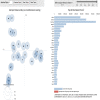Thinking Aloud or Screaming Inside: Exploratory Study of Sentiment Around Work
- PMID: 36178712
- PMCID: PMC9568814
- DOI: 10.2196/30113
Thinking Aloud or Screaming Inside: Exploratory Study of Sentiment Around Work
Abstract
Background: Millions of workers experience work-related ill health every year. The loss of working days often accounts for poor well-being because of discomfort and stress caused by the workplace. The ongoing pandemic and postpandemic shift in socioeconomic and work culture can continue to contribute to adverse work-related sentiments. Critically investigating state-of-the-art technologies, this study identifies the research gaps in recognizing workers' need for well-being support, and we aspire to understand how such evidence can be collected to transform the workforce and workplace.
Objective: Building on recent advances in sentiment analysis, this study aims to closely examine the potential of social media as a tool to assess workers' emotions toward the workplace.
Methods: This study collected a large Twitter data set comprising both pandemic and prepandemic tweets facilitated through a human-in-the-loop approach in combination with unsupervised learning and meta-heuristic optimization algorithms. The raw data preprocessed through natural language processing techniques were assessed using a generative statistical model and a lexicon-assisted rule-based model, mapping lexical features to emotion intensities. This study also assigned human annotations and performed work-related sentiment analysis.
Results: A mixed methods approach, including topic modeling using latent Dirichlet allocation, identified the top topics from the corpus to understand how Twitter users engage with discussions on work-related sentiments. The sorted aspects were portrayed through overlapped clusters and low intertopic distances. However, further analysis comprising the Valence Aware Dictionary for Sentiment Reasoner suggested a smaller number of negative polarities among diverse subjects. By contrast, the human-annotated data set created for this study contained more negative sentiments. In this study, sentimental juxtaposition revealed through the labeled data set was supported by the n-gram analysis as well.
Conclusions: The developed data set demonstrates that work-related sentiments are projected onto social media, which offers an opportunity to better support workers. The infrastructure of the workplace, the nature of the work, the culture within the industry and the particular organization, employers, colleagues, person-specific habits, and upbringing all play a part in the health and well-being of any working adult who contributes to the productivity of the organization. Therefore, understanding the origin and influence of the complex underlying factors both qualitatively and quantitatively can inform the next generation of workplaces to drive positive change by relying on empirically grounded evidence. Therefore, this study outlines a comprehensive approach to capture deeper insights into work-related health.
Keywords: Bayesian inference; artificial intelligence; machine learning; mobile phone; natural language processing; occupational health; sentiment analysis; work-related mental health.
©Marzia Hoque Tania, Md Razon Hossain, Nuzhat Jahanara, Ilya Andreev, David A Clifton. Originally published in JMIR Formative Research (https://formative.jmir.org), 30.09.2022.
Conflict of interest statement
Conflicts of Interest: None declared.
Figures








Similar articles
-
Digital Epidemiology of Prescription Drug References on X (Formerly Twitter): Neural Network Topic Modeling and Sentiment Analysis.J Med Internet Res. 2024 Aug 23;26:e57885. doi: 10.2196/57885. J Med Internet Res. 2024. PMID: 39178036 Free PMC article.
-
Patient Voices in Dialysis Care: Sentiment Analysis and Topic Modeling Study of Social Media Discourse.J Med Internet Res. 2025 May 15;27:e70128. doi: 10.2196/70128. J Med Internet Res. 2025. PMID: 40372782 Free PMC article.
-
Topics, Trends, and Sentiments of Tweets About the COVID-19 Pandemic: Temporal Infoveillance Study.J Med Internet Res. 2020 Oct 23;22(10):e22624. doi: 10.2196/22624. J Med Internet Res. 2020. PMID: 33006937 Free PMC article.
-
Sentiment Analysis of Health Care Tweets: Review of the Methods Used.JMIR Public Health Surveill. 2018 Apr 23;4(2):e43. doi: 10.2196/publichealth.5789. JMIR Public Health Surveill. 2018. PMID: 29685871 Free PMC article. Review.
-
Sentiment Analysis in Social Media Data for Depression Detection Using Artificial Intelligence: A Review.SN Comput Sci. 2022;3(1):74. doi: 10.1007/s42979-021-00958-1. Epub 2021 Nov 19. SN Comput Sci. 2022. PMID: 34816124 Free PMC article. Review.
Cited by
-
Consistency Analysis of Practice Orientation of the Healthy Enterprise Program in China.BMC Public Health. 2025 Jun 4;25(1):2090. doi: 10.1186/s12889-025-23351-6. BMC Public Health. 2025. PMID: 40468241 Free PMC article.
-
Relationship between duration of sick leave and time variation of words used in return-to-work programs for depression.Work. 2024;77(3):981-991. doi: 10.3233/WOR-230083. Work. 2024. PMID: 37781845 Free PMC article.
References
-
- Health and safety executive homepage. HSE. 2022. [2022-06-08]. https://www.hse.gov.uk .
-
- Labour Force Survey. Office for National Statistics. 2020. [2022-06-08]. https://www.ons.gov.uk/surveys .
-
- Leach C, Finning K, Kerai G, Vizard T. Coronavirus and depression in adults, Great Britain: July to August 2021. Office for National Statistics. 2021. Oct 1, [2022-06-08]. https://www.ons.gov.uk/peoplepopulationandcommunity/wellbeing/articles/c... .
-
- The five-year forward view for mental health. NHS England. 2016. Feb, [2022-06-08]. https://www.england.nhs.uk/wp-content/uploads/2016/02/Mental-Health-Task... .
-
- Mental health and substance use. World Health Organization. [2022-06-08]. https://www.who.int/teams/mental-health-and-substance-use/overview .
LinkOut - more resources
Full Text Sources

